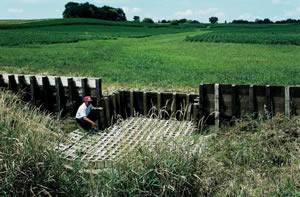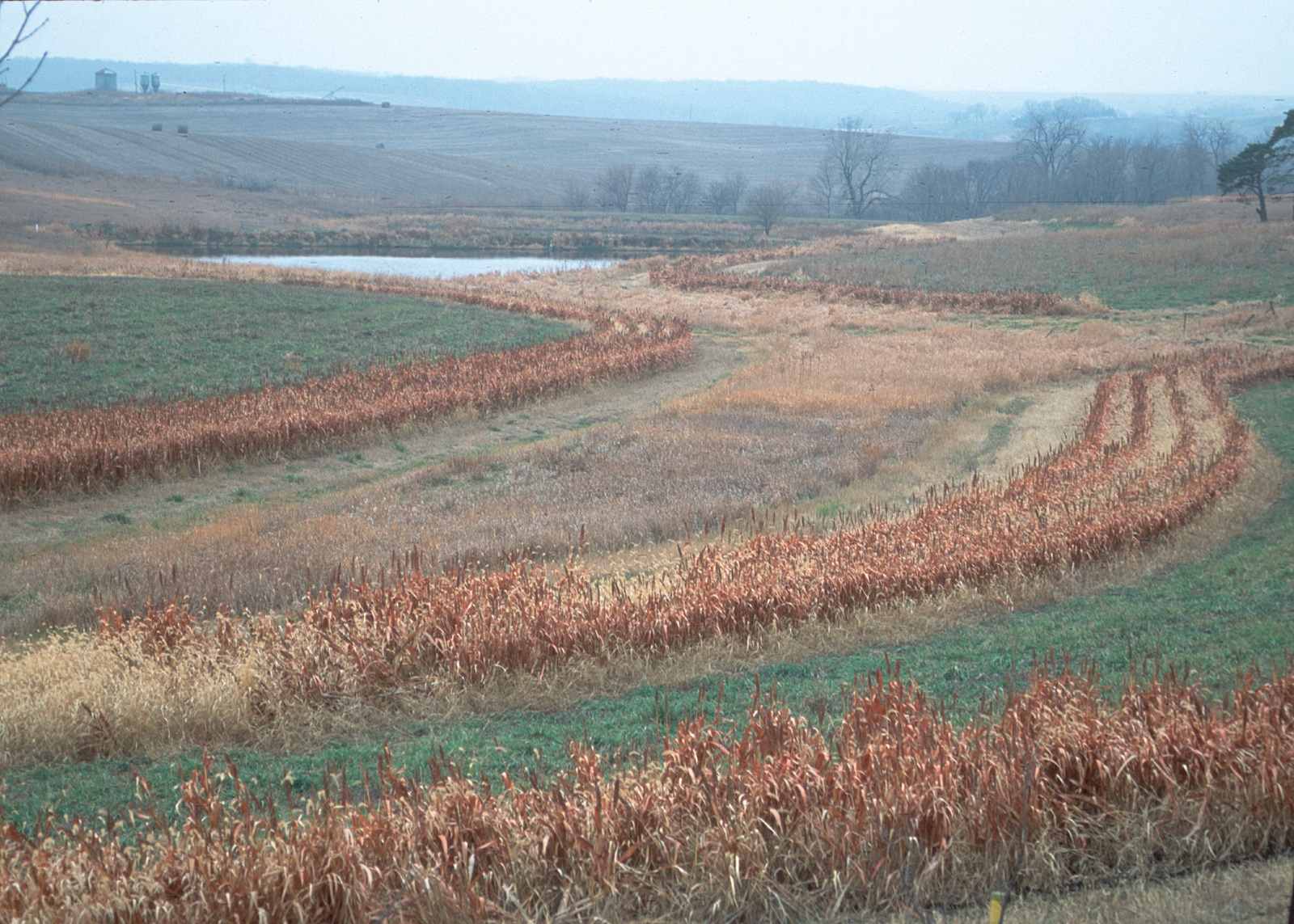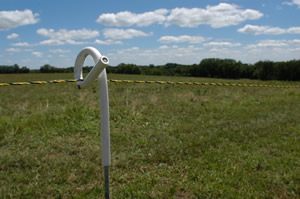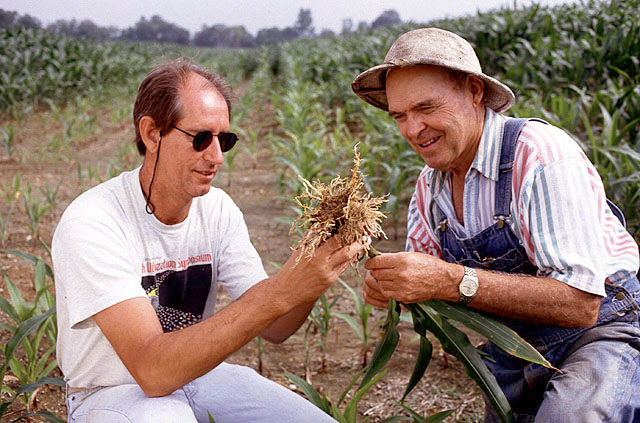-
Download:
My Results |
All BMPs
Field Borders
Category: Conservation Buffers, Erosion Control
Practice Type: Structural
Landuse/Agriculture Type: Row Crop, Pasture, Fodder, Rice, Small Grains
Climatic Zones: Temperate, Semiarid, Tropical
Regions: North America, South Asia, Europe
Pollutants Treated: Nitrogen, Phosphorus, Sediment
Description: Field borders are strips of vegetation planted at the edge of fields that can mark the edge of field or property boundary. Some field borders can be grassy and provide turn areas or travel lanes for machinery. Other field borders may consist of hedges, shrubs, grasses and trees and have the potential of providing wildlife habitat and windbreaks. Field borders can help trap sediment, reduce erosion and runoff, improve infiltration, and minimize nutrient losses at the edge of the field. 1
Implementation Considerations: Field borders reduce the land available to grow crop. Studies have found that crops next to wooded field borders may suffer from reduced yields as a result of shade effects and water competition. Herbaceous crop borders, however, show negligible impacts on crop yields.
Scalable to small farms? Yes
1 "Conservation Buffers." Conservation Technology Information Center. Web. Aug. 2014. http://www.ctic.purdue.edu/Core4/Conservation Buffers/
Practice Type: Structural
Landuse/Agriculture Type: Row Crop, Pasture, Fodder, Rice, Small Grains
Climatic Zones: Temperate, Semiarid, Tropical
Regions: North America, South Asia, Europe
Pollutants Treated: Nitrogen, Phosphorus, Sediment
Description: Field borders are strips of vegetation planted at the edge of fields that can mark the edge of field or property boundary. Some field borders can be grassy and provide turn areas or travel lanes for machinery. Other field borders may consist of hedges, shrubs, grasses and trees and have the potential of providing wildlife habitat and windbreaks. Field borders can help trap sediment, reduce erosion and runoff, improve infiltration, and minimize nutrient losses at the edge of the field. 1
Implementation Considerations: Field borders reduce the land available to grow crop. Studies have found that crops next to wooded field borders may suffer from reduced yields as a result of shade effects and water competition. Herbaceous crop borders, however, show negligible impacts on crop yields.
Scalable to small farms? Yes
1 "Conservation Buffers." Conservation Technology Information Center. Web. Aug. 2014. http://www.ctic.purdue.edu/Core4/Conservation Buffers/
Grade Stabilization
 Grade stabilization structure at the outlet of a grassed waterway: Full-flow block drop spillway made of wood and cabled concrete. Photo courtesy of USDA NRCS.
Grade stabilization structure at the outlet of a grassed waterway: Full-flow block drop spillway made of wood and cabled concrete. Photo courtesy of USDA NRCS.
Practice Type: Structural
Landuse/Agriculture Type: Row Crop, Pasture, Fodder
Climatic Zones: Temperate, Semiarid, Tropical
Regions: North America, Europe, Africa, Asia
Pollutants Treated: Sediment
Description: A grade stabilization structure is an embankment or spillway built across a drainageway to prevent soil erosion and the formation or advancement of gullies. Grade stabilization structures are also used to stabilize erosion-prone sites where a tributary or tile drainage outlet enters a channel such as a ditch from the side; the grade stabilization structure slows the flow of water from the higher elevation of the tributary or side-inlet (where water is entering) to the lower elevation of the channel. Grade stabilization structures are especially important in areas where sediment loading from gully erosion is a major water quality concern. Grade control structures can improve water quality by reducing soil erosion and nutrient losses from runoff.1
Implementation Considerations: Grade stabilization structures should generally be planned and installed along with, or as a part of, other conservation practices in an overall surface water disposal system. In particular, grade stabilization structures work best and last longer when upland runoff is controlled by practices like contour farming, conservation tillage, water and sediment control basins, terraces, cover crops, rotational grazing and grass planting.
Scalable to small farms? Yes
1 Miller, T. P. , J. R. Peterson, C. F. Lenhart, and Y. Nomura. 2012. The Agricultural BMP Handbook for Minnesota. Minnesota Department of Agriculture.;"Standard and Specifications for Grade Stabilization Structure." New York Standards and Specifications For Erosion and Sediment Control. 1 Aug. 2005. Web. 1 July 2014. http://www.dec.ny.gov/docs/water_pdf/sec5bperm6.pdf .
Grassed Waterways
 Food plots border a grassed waterway in Union County SWCD, Iowa. Photographer: Lynn Betts. Photo Courtsey of USDA NRCS.
Food plots border a grassed waterway in Union County SWCD, Iowa. Photographer: Lynn Betts. Photo Courtsey of USDA NRCS.
Practice Type: Structural
Landuse/Agriculture Type: Row Crop, Pasture, Fodder
Climatic Zones: Temperate, Tropical
Regions: North America, Europe
Pollutants Treated: Nitrogen, Phosphorus, Sediment
Description: A grassed waterway is a natural or constructed swale, shaped or graded and established in suitable vegetation for the safe conveyance of runoff. Grassed waterways are designed to prevent soil erosion while draining runoff water from adjacent cropland. As water travels down the waterway, the grass vegetation prevents erosion that would otherwise result from concentrated flows and uptakes nutrients. Grassed waterways also help prevent gully erosion in areas of concentrated flow. For example, they may be used to drain runoff from terraces and runoff water diversions. By intercepting runoff, grassed waterways slow erosion and minimize nutrient losses. 1
Implementation Considerations: Grassed waterways work best when erosion is controlled on the contributing upland drainage area; otherwise, the waterways could become clogged by sediment. The construction of a grassed waterway can disturb large areas and potentially affect cultural resources.
Scalable to small farms? Yes
1 Green, C.H., and R. Haney. "Grassed Waterways." SERA-17, Minimizing Phosphorus Losses from Agriculture. Web. Jan. 2014. http://www.sera17.ext.vt.edu/Documents/BMP_Grassed_Waterways.pdf .; "Grassed Waterways." Natural Resources Conservation Service, Conservation Practice Standard. Web. Jan. 2014. http://www.nrcs.usda.gov/Internet/FSE_DOCUMENTS/nrcs143_026051.pdf .
Grazing/Pasture Management
 Lightweight portable fence used in a rotational grazing system to adjust paddock boundaries as needed, based on grass growth and livestock forage needs. Photo courtesy of USDA NRCS.
Lightweight portable fence used in a rotational grazing system to adjust paddock boundaries as needed, based on grass growth and livestock forage needs. Photo courtesy of USDA NRCS.
Practice Type: Structural, Management
Landuse/Agriculture Type: Pasture
Climatic Zones: Temperate, Semiarid, Tropical
Regions: North America, Europe, South America, South Asia, South Africa
Pollutants Treated: Nitrogen, Phosphorus, Sediment
P Efficiency1: 20%
S Efficiency1: 40%
Description: Grazing/pasture management can include a series of practices including maintaining proper stocking rates, rotational grazing, proper application of fertilizers and spreading of manure, maintenance of animal trails and walkways, and weed management. This suite of practices promotes healthy stands of grass, controls weeds, prevents overgrazing, and reduces runoff and erosion from pastures. 2
Implementation Considerations: Pasture/Grazing management can be labor intensive and requires investments in fencing and offstream watering.
Scalable to small farms? Yes
1 "Documentation: Source Data, BMP Effectiveness Values." Chesapeake Assessment Scenario Tool. Web. 2013. http://casttool.org/Documentation.aspx .
2 Estimates of County-level Nitrogen and Phosphorus Data for Use in Modeling Pollutant Reduction Documentation for Scenario Builder Version 2.2." Chesapeake Bay. Dec. 2010. Web. May 2013. http://archive.chesapeakebay.net/pubs/SB_V22_Final_12_31_2010.pdf.
Gypsum Soil Ammendments
 Soil scientists Darrell Norton (left) and Ralph Woodward, a cooperating corn farmer, assess the effect of field application of gypsum on plant root growth. Photo by Keith Weller. Photo Courtesy of USDA ARS.
Soil scientists Darrell Norton (left) and Ralph Woodward, a cooperating corn farmer, assess the effect of field application of gypsum on plant root growth. Photo by Keith Weller. Photo Courtesy of USDA ARS.
Practice Type: Management
Landuse/Agriculture Type: Row Crop, Small Grains, Fodder
Climatic Zones: Temperate, Tropical
Regions: North America
Pollutants Treated: Nitrogen, Phosphorus
Description: Gypsum, or calcium sulfate, is a soil ammendment that can increase infiltration in sodic and clay soils which in turn reduces overland runoff that can carry sediment bound N and P. Gypsum can also increase nitrogen use efficiency, reducing the overall need for nitrogen fertilizer. 1
Implementation Considerations: In the United States, gypsum has become readily available and inexpensive because it is a byproduct of scrubbing sulfur dioxide gasses from the emissions of coal-fired power plants. Gypsum increases nitrogen use efficiency by supplying the crop with sulfur which in turn allows it to efficienty utilize nitrogen. However, to realize nitrogen efficiency gains, nitrogen must be applied at optimal rates; gypsum was actually found to lower yields in cases where nitrogen was applied at sub-optimal rates.
Scalable to small farms? Yes
1 Fisher, Madeline. "Amending Soils with Gypsum." American Society of Agronomy. Crops & Soils magazine, December 2011. https://www.agronomy.org/files/publications/crops-and-soils/amending-soils-with-gypsum.pdf
